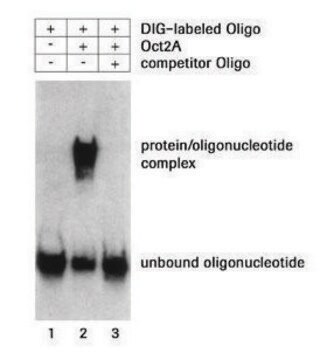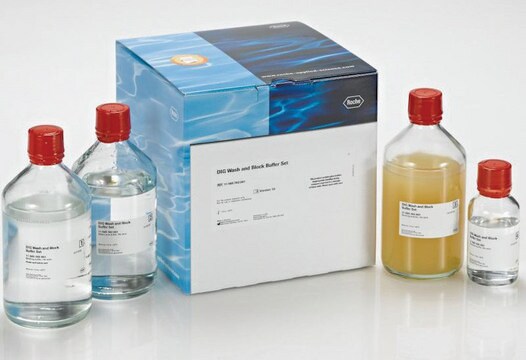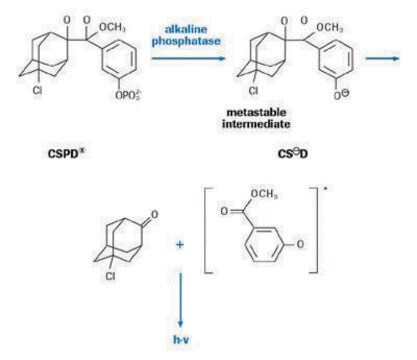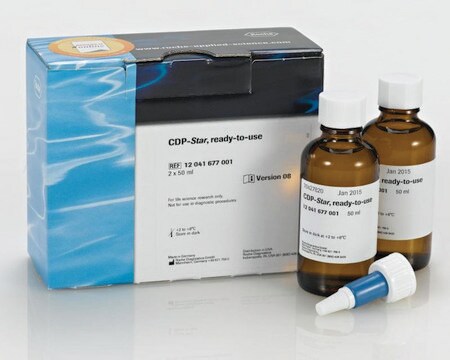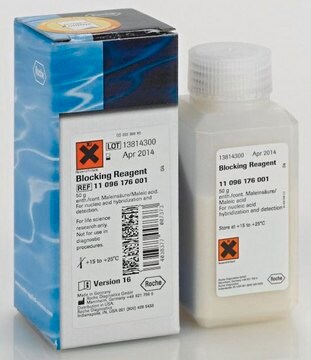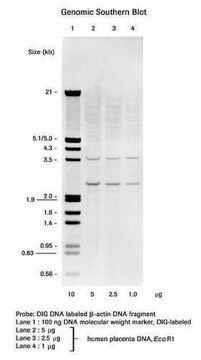03353583910
Roche
DIG Oligonucleotide Tailing Kit, 2nd generation
sufficient for 25 reactions (100 pmol oligonucleotide per assay; 1 ug of a 30-mer oligonucleotide)
About This Item
Produits recommandés
Utilisation
sufficient for 25 reactions (100 pmol oligonucleotide per assay; 1 ug of a 30-mer oligonucleotide)
Niveau de qualité
Fabricant/nom de marque
Roche
Conditions de stockage
avoid repeated freeze/thaw cycles
Caractéristiques du produit alternatif plus écologique
Designing Safer Chemicals
Learn more about the Principles of Green Chemistry.
sustainability
Greener Alternative Product
Autre catégorie plus écologique
Description générale
Application
- northern blot assay
- in situ hybridization (ISH)
- fluorescence in situ hybridization (FISH)
Caractéristiques et avantages
- Very sensitive hybridization probes, due to the incorporation of several DIG-nucleotides
- Fast hybridization kinetics, due to the small size of oligonucleotides
- Single-stranded probes, no renaturation during hybridization
- Sequence can be designed according to the experiment
- Specially suited for in situ hybridization; due to their small size, oligonucleotides readily diffuse into fixed tissues and cells
Conditionnement
Principe
Notes préparatoires
In one standard labeling reaction up to 100 pmol oligonucleotide (1 μg of a 30-mer oligonucleotide) can be applied.
Stockage et stabilité
Autres remarques
Composants de kit seuls
- Reaction Buffer 5x concentrated
- CoCl<SUB>2</SUB> Solution 25 mM
- DIG-dUTP Solution 1 mM
- dATP Solution 10 mM
- Recombinant Terminal Transferase 400 U/μl
- Control Oligonucleotide, unlabeled 20 pmol/μl
- Oligonucleotide, DIG-dUTP/dATP tailed 2.5 pmol/μl
- Control DNA 0.25 mg/ml
- Glycogen Solution 20 mg/ml
- DNA Dilution Buffer, 50 μg/ml fish sperm DNA
- Poly(A) Solution 10 mg/ml
Mention d'avertissement
Danger
Mentions de danger
Conseils de prudence
Classification des risques
Acute Tox. 4 Inhalation - Acute Tox. 4 Oral - Aquatic Chronic 2 - Carc. 1B Inhalation - Repr. 1B
Code de la classe de stockage
6.1D - Non-combustible, acute toxic Cat.3 / toxic hazardous materials or hazardous materials causing chronic effects
Classe de danger pour l'eau (WGK)
WGK 3
Point d'éclair (°F)
does not flash
Point d'éclair (°C)
does not flash
Certificats d'analyse (COA)
Recherchez un Certificats d'analyse (COA) en saisissant le numéro de lot du produit. Les numéros de lot figurent sur l'étiquette du produit après les mots "Lot" ou "Batch".
Déjà en possession de ce produit ?
Retrouvez la documentation relative aux produits que vous avez récemment achetés dans la Bibliothèque de documents.
Les clients ont également consulté
Articles
Digoxigenin (DIG) labeling methods and kits for DNA and RNA DIG probes, random primed DNA labeling, nick translation labeling, 5’ and 3’ oligonucleotide end-labeling.
Notre équipe de scientifiques dispose d'une expérience dans tous les secteurs de la recherche, notamment en sciences de la vie, science des matériaux, synthèse chimique, chromatographie, analyse et dans de nombreux autres domaines..
Contacter notre Service technique
